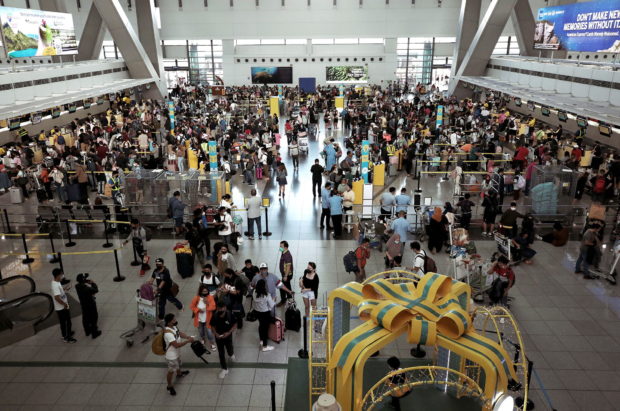
NEW YEAR CHAOS In this photo taken on Jan. 2, passengers queue at Ninoy Aquino International Airport Terminal 3 in Pasay City following the resumption of operations. On New Year’s Day, more than 300 flights to and from Manila were canceled due to equipment breakdown that shut down the Philippine airspace. —RICHARD A. REYES
MANILA, Philippines — Top national security, transportation, and airport officials have been summoned separately by the Senate and House of Representatives which are conducting their respective inquiries into the power outage that caused vital air traffic navigation system to go offline and shut down the country’s airspace on Jan. 1.
On Tuesday, officials of the Department of Transportation, Civil Aviation Authority of the Philippines (CAAP), and other concerned government agencies will brief House transportation panel members on the airport fiasco that stranded around 65,000 passengers and grounded over 300 flights in and out of Ninoy Aquino International Airport (Naia).
Antipolo City Rep. Romeo Acop, who will preside over the 10 a.m. briefing, earlier filed a resolution for his panel to conduct an investigation into the incident while San Jose del Monte City Rep. Florida Robes, House good government and accountability committee chair, submitted a similar measure.
The Senate will hold its own hearing on Jan. 12 under Sen. Grace Poe’s public services committee. On Monday, Poe said the possibility that the New Year’s Day incident was an act of sabotage or a cyberattack should not be ruled out since CAAP had yet to explain the power outage that downed its communications, navigation, and surveillance/air traffic management (CNS/ATM) system.
Poe said that aside from airport and transportation officials, National Security Adviser Clarita Carlos and representatives from the Department of Information and Communications Technology and the National Security Council had been invited to the hearing as well.
Representatives of Sumitomo-Thales, the joint venture that provided the CNS/ATM system, were also set to attend.
Numerous theories
“There are many theories (why the incident happened). That’s why we would like to hear it straight from them,” Poe said in a television interview.
“We want to know what really happened. I was talking to (individuals)… connected with one of those that supply the maintenance. They were saying, ‘Don’t rule out a cyberattack for this or sabotage.’ Because until now there’s really no categorical answer to what caused the power outage,” she added.
She said it was “unfortunate” that the government had failed to pursue a project that would have unified the country’s military and commercial air navigation system.
“When we were supposed to upgrade the system for the air traffic control, there was supposed to be one system that would merge both our national security and defense, as well as our commercial airspace. But unfortunately, that was not done,” Poe lamented.
“Our military [has its] own system to determine if there’s a violation of our airspace, but it’s not connected with the CAAP system,” she said.
Asked whether Transportation Secretary Jaime Bautista should quit his post over the incident, Poe said: “Absolutely not.”
“First of all, Bautista was just sworn into office and this is a long-standing situation,” she noted.
“This didn’t just happen overnight,” she added. “Obviously, it stems from many years of transactions, maintenance, and upgrades.”
Poe said her committee had also invited former Transportation Secretary Arthur Tugade, who earlier denied allegations that he had diverted a P13-billion allotment for the upgrading of the CNS/ATM system to Naia beautification projects.
“(We’re) not just singling out Secretary Tugade. This is a chance for him also to correct the impression that it was during his time that all these things may have been neglected,” she said.
Wake-up call
For Sen. Juan Edgardo Angara, the airport fiasco should be a “wake-up call” for the government to strengthen CAAP and improve the country’s air traffic navigation system.
He said he had filed Senate Bill No. 1003 as “part of the efforts to ensure the safety, reliability, and efficiency of air transport in our country.”
Under the measure, the secretaries of the Department of Tourism and the Department of National Defense would become members of the CAAP governing board.
“The technical glitch… was a wake-up call for all of us about the need to address the gaps in our air transport systems and the CAAP is front and center in all of this,” Angara said.
After the Jan. 1 incident, CAAP Director General Manuel Tamayo acknowledged that the agency’s CNS/ATM system, which was completed in 2019, was already outdated, adding that they had made some recommendations for its improvement to President Ferdinand Marcos Jr.
The system suddenly went offline on the morning of Jan. 1 due to a power supply problem. Two uninterruptible power supply units also failed to work, leaving the air navigation system unable to tap into commercial or standby power.
After conducting some troubleshooting, CAAP technicians were able to restore partial operations around 4 p.m. with the CNS/ATM system returning to normal mode almost two hours later. But by then, over 300 flights to and from Manila had either been canceled, delayed, or diverted, affecting around 65,000 passengers flying to their destinations after the holidays.